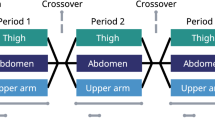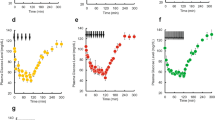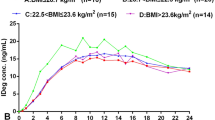Summary
One of the reasons for the variability of blood glucose regulation in Type 1 (insulin-dependent) diabetic patients is the huge variation in subcutaneous absorption of intermediate-acting insulin. We have investigated the variation in insulin absorption during continuous subcutaneous insulin infusion in eight such patients. The content of insulin in the subcutaneous tissue was measured using 125I-labelled insulin. The concentration of free serum insulin and blood glucose was followed from 1 h before and from 7 h after breakfast on two consecutive days. The amount of insulin absorbed during 24 h differed in all cases by less than 3% from the daily insulin dose given by the pumps. Mean insulin absorption rates and mean free insulin concentration showed peak values 30–90 min after meal bolus injections; this was sufficient to maintain near-normal blood glucose. Mean free serum insulin correlated strongly with disappearance of insulin from the subcutaneous tissue (r=0.98). From the insulin absorption rates and free insulin concentrations during basal constant insulin infusion, the half-time of serum insulin was calculated as 6 min. Compared with the known large variability in the absorption of intermediate-acting insulin, continuous subcutaneous insulin infusion offers a precise and reproducible way of insulin administration resulting in post-prandial serum insulin peaks sufficient to maintain near-normal blood glucose levels. The half-time of serum insulin during subcutaneous infusion corresponds to values for intravenous infusion given in the literature, indicating that local degradation of insulin in subcutaneous tissue is of minor importance.
Article PDF
Similar content being viewed by others
Avoid common mistakes on your manuscript.
References
Lauritzen T, Faber OK, Binder C (1979) Variation in 125I-insulin absorption and blood glucose concentration. Diabetologia 5: 291–295
Molnar CD, Taylor WF, Langworthy AL (1972) Plasma immunoreactive insulin patterns in insulin-treated diabetics. Studies during continuous blood glucose monitoring. Mayo Clinic 47: 709–719
Lauritzen T, Frost-Larsen K, Svendsen P Aa, Larsen H-W, Deckert T, Christiansen JS, Parving H-H, Binder C, Nerup J, Deckert M, Larsen A, Lørup B, Bojsen J, Bech-Jansen L (1982) Effect of 6 months of strict metabolic control on eye and kidney function in insulin-dependent diabetics with background retinopathy. Lancet 1: 121–124
Lauritzen T, Deckert T, Svendsen P Aa, Larsen H-W, Frost-Larsen K, Christiansen JS, Parving H-H, Binder C, Nerup J, Deckert M, Larsen A, Lørup B, Bojsen J, Bech-Jansen L (1982) One year's experience of insulin pumps in diabetes. Nordisk Medicin 97: 130–133 (in English)
Pickup JC, White MC, Keen H, Parsons JA, Alberti KGMM (1979) Long-term continuous subcutaneous insulin infusion in diabetics at home. Lancet 2: 870–873
Hansen B, Linde S, Kølendorf K, Jensen F (1979) Absorption of protamine-insulin in diabetes. I. Preparation and characterization of protamine-125I-insulin. Horm Metab Res 11: 85–90
Binder C (1969) Absorption of injected insulin. Acta Pharmacol Toxicol (Suppl 2) 27: 1–84
Mayer SE, Melmon KL, Gilman AG (1980) Introduction; the dynamics of drug absorption, distribution and elimination. In: Goodman GS, Gilman AG, Gilman A (eds) The pharmacological basis of therapeutics, 6th edn. Macmillan, New York, pp 21–27
Frost DP, Srivastava MC, Jones RH, Nabarro JDN, Sonksen PH (1973) The kinetics of insulin metabolism in diabetes. Postgrad Med J (Suppl 49): 949–954
Lauritzen T, Pramming S, Gale EAM, Deckert T, Binder C (1982) The absorption of NPH insulin and its clinical implications. Br Med J 285: 159–162
Author information
Authors and Affiliations
Rights and permissions
About this article
Cite this article
Lauritzen, T., Pramming, S., Deckert, T. et al. Pharmacokinetics of continuous subcutaneous insulin infusion. Diabetologia 24, 326–329 (1983). https://doi.org/10.1007/BF00251817
Received:
Revised:
Issue Date:
DOI: https://doi.org/10.1007/BF00251817




